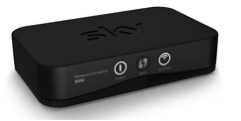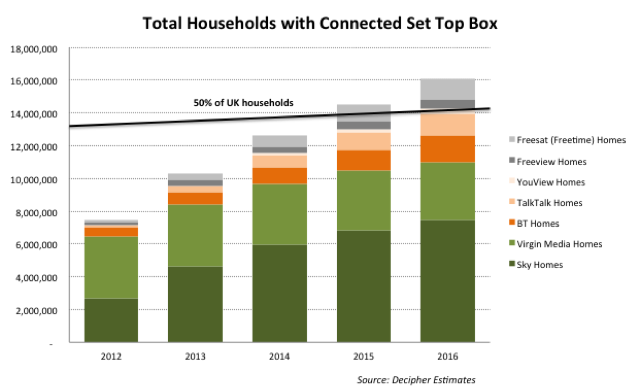Over 50% of UK households will have a connected STB by end of 2015 which is double the figure for last year. This will move TV on-demand mainstream. It will also move consumers’ default usage back to the digital TV platforms and dampen the growth of OTT providers (Netflix and Lovefilm) and standalone online players (iPlayer, ITV on demand and 4OD).
Set-top boxes in the UK are getting more connected. This means that more of them have access to broadband through either a cable into the back of them or, more likely, a wifi connection. The trend is prevalent at the moment driven by Sky who are currently connecting 50k HD boxes per week[1] and will continue to for the next few years. Added acceleration to connectivity will come from YouView growth through BT and TalkTalk and also the connected version of Freesat (called <freetime>) which are both making the traditionally ‘free TV’ base more able to easily connect to broadband.
Since August this year, Sky+HD boxes have been sold with built-in wifi, making it easier for customers to watch Sky’s on demand service. For the past two years, Sky have also offered a wifi connector which they are now actively marketing to their existing base (often for free). This means that if your current Sky+ box is not close enough to your broadband router to allow an ethernet cable to make it connected, this box will allow wifi to do the job.
Decipher estimate that by the end of 2015, over half of UK set top boxes will be connected to broadband (14.5m) and that 57% will be connected by end of 2015 (16.1m).
The biggest benefit to consumers from broadband connectivity is access to on-demand. Sky customers who connect will get access to on-demand catch-up services including catch-up content from the PSBs as well as catch-up from many pay channels. Sky’s premium movie subscribers will also benefit from watching their movies on-demand rather than waiting for the right start time on their linear movie channels. It could be argued that Sky was slow to enter the on-demand game and underestimated the impact that catch-up, in particular, would have. This allowed online standalone players to gain traction as well a multitude of different ways to access catch-up players on other devices such as smart TVs, games consoles, ‘puck’ box etc. When Sky realised that customers were even temporarily leaving the Sky environment and using their smart TVs to watch iPlayer, they realised the problem they had. They also worried about the growth of set top box free, subscription services such as Netflix and Lovefilm with one of their main marketing claims being the pure on-demand nature of their offering. This is what Sky are addressing through their push for rapid connectivity of their base. The other main pay TV platform, VirginMedia, has been almost entirely connected for many years now and so has already reaped the benefits of connectivity and has a strong on-demand line-up. A secondary benefit and one that is yet to be fully realised is the ability for consumers to upgrade and alter their digital TV subscription packages through their set-top box.
YouView and Freesat’s <freetime> STB have broadband connectivity at their core and users get access to all the PSB players and backwards EPG with this. Decipher forecast that these two platforms will grow significantly over the next few years especially as they introduce lower priced zapper boxes which have no hard disk but are still connected to the internet. There are some freeview boxes that are connected and many more Smart TVs but the active user base numbers are actually small. However, one trend is clear; even the traditionally ‘subscriber resistant’ end of the digital TV landscape is becoming connected.
What does this rise in connectivity mean for the digital video industry here in the UK? Decipher think it will have five main impacts:
1) On-demand becomes mainstream and will start to steal time away from traditional linear and DVR viewing albeit slowly (habits change slowly).
2) OTT providers lose some of their competitive advantage and their growth slows – their business model will pivot towards becoming a premium channel rather than a platform.
3) Online stand alone players such as iPlayer and 4OD start to see viewing moving from their own controlled online players to being accessed through the digital TV platforms
4) Smart TV screens will really suffer as their offering becoming significantly weaker that the digital TV platforms. Their ‘Home’ screen will fail to become the default TV environment that consumers access for TV watching and catch-up services.
5) Digital TV platforms will strengthen their hold on the home and start to move towards being the dominant provider of all video access in every room and outside the home.
In the longer term, there is a scenario where the set-top box disappears and we move to an entirely browser based way of accessing our content. This is starting to happen in the US and Europe to some degree (see Aereo in US and Magine in Sweden). However, we believe that the next generation of TV will still be set top box based. The key to unlocking this world, Decipher still believes, is the network DVR and associated rights availability.
The rise in connectivity is an important trend in the UK and is very much welcomed by consumers who will start to default to on-demand more and more. However, it will start to consolidate power in the hands of the digital TV platforms which will reduce the level of UK competition for video access.
Decipher provides consulting services to many European digital TV platforms, channels, and content and studio owners. FutureMedia is Decipher’s flagship syndicated product that allow our clients quarterly access to Decipher’s thinking about an important industry topic – Q4 2013 Dynamic Advertising in TV; Q1 2014 – How European TV markets differ. For more information about Decipher’s consulting service or FutureMedia, please email Damien.Read@Decipher.co.uk or call +44 208 747 4590
[1] BSkyB Unaudited results for the three months ended 30 September 2013


